In this issue, we will bring you the effect of 5-ALA on promoting apple fruit coloring.
In this study, it was detailed that 5-ALA improved the appearance quality by increasing the anthocyanin content of apple peel! It also improves the taste and sweetness of the fruit! Enhance the inner quality! It also did not shorten the shelf life of the fruit

5-ALA (aLa) is the first key precursor in the biosynthesis of porphyria compounds in all organisms, and its synthesis and metabolism have been extensively studied. ALA is not only a product of biological metabolism, but also participates in the regulation of plant growth and development, so it has important potential application value in agricultural production. The results showed that 10 mg/L exogenous ALA irrigated roots could increase the photosynthetic rate and cold resistance of melon seedlings under low light. In Chinese cabbage, it can promote seed germination under salt stress, improve the photosynthetic efficiency of seedling leaves, and promote the distribution of assimilate products to the root system. However, studies on the effects of ALA on plant growth and development have just begun, and many physiological functions remain to be further explored. Considering that ALA is a precursor of plant photosensitin biosynthesis [and photosensitin is closely related to apple coloring], we hypothesized that ALA may have the effect of promoting apple coloring. In order to provide a new technique for apple production practice, we reported for the first time the effect of ALA on promoting apple coloring and improving fruit quality.
Materials and methods
1.1 Site profile Experiments were conducted in Shunhe Orchard in Fengxian County and Heda Orchard in Peixian County, Jiangsu Province respectively
1.2 Experimental materials Red Fuji apples were bagged for 12 years old in Shunhe Orchard, and red Fuji apples were unbagged for 10 years old in Tianda Orchard.
1.3 Test methods 20 days before fruit harvesting, fruits were impregnated with ALA(Sigma product, plus Tween 0.01%) solution at concentrations of 100, 300 and 500 mg/L, respectively, with 10 fruits for each treatment. Water treatment was used as the control. Single plant block group was repeated 5 times. For previously unbagged fruit, treat directly with ALA solution: for previously bagged fruit, remove the bag first and then treat with ALA. When the fruits reached the commercial maturity stage, the harvest began, and 2 fruits were selected from each repeat, that is, every 10 fruits were treated, the hardness of the fruit (with skin) and the hardness of the flesh (without skin) were measured, and then the skin was randomly cut from the body of the fruit (4 pieces of each fruit, the thickness of about 0.5mm), a total of 40 pieces. After mixing, they were evenly divided into three groups and weighed.
1.4 Determination items and methods The contents of epidermal anthocyanin 17 chlorophyll and carotenoid [8] in fruits were determined by colorimetry. The fruit pulp was pressed into juice. The pH of the fruit juice was determined by Beckman with pH 61 meter, the soluble solid content was determined by hand-held refractometer, and the titrable acid content was determined by acid-base titration. Endogenous ALA was determined by Harel and Klein9 methods. A certain amount of apple peel or pulp tissue was extracted by grinding with pH4.6 acetic acid buffer solution. After centrifugation, 1mL of supernatant was taken and added with a certain amount of acetyl acetone, condensed at 100 ℃ for 10 min. After cooling, 1mL of color developing solution was added (containing 1g p-dimethylaminobenzenaldehyde dissolved in 30mL glacial acetic acid, adding 8 mL perchloric acid and then containing it in distilled water to 50mL) for 5~10 min. Colorimetry at 553 nm with UV-VIS spectrophotometer. The standard curve is made according to ALA produced by Sigma Company. The fruit respiration rate was measured according to the method of Zhao Shijie et al. [10]. Before the determination, the apple fruits (6 to 8) stored at room temperature were first placed in the dryer, and the CO concentration in the container was measured by the CO infrared system after a certain period of time, and then converted into the CO content released by the fruit respiration per unit time, which was used as the fruit respiration rate.
1.5 Data Processing and Statistical analysis All the above measurements were repeated for more than 3 times, and the average values were taken and used as Duncan'S test.
Results and analysis
2.1 Effects of ALA treatment on epidermal pigment content of apple fruits
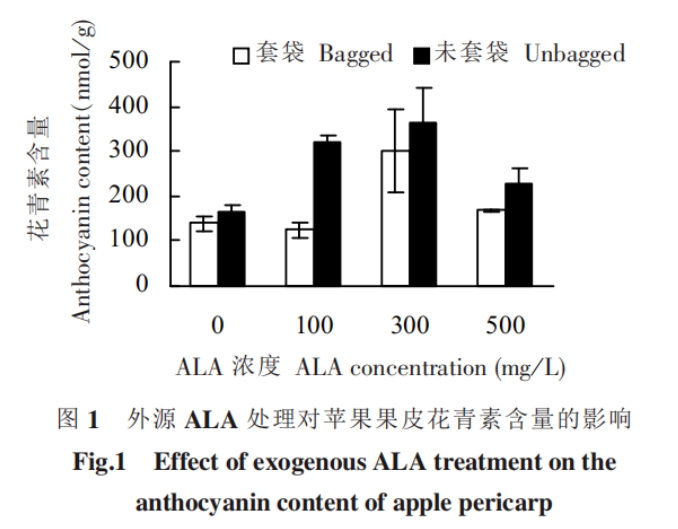
As can be seen from the above results, the surface color and finish of apples treated with ALA were significantly higher than that of control fruits. FIG. 1 also showed that exogenous ALA treatment significantly increased the anthocyanin content of apple peel (measured by fresh weight). The effect of ALA treatment on bagged fruits reached a very significant level, and the epidermal anthocyanin content of 300mg/L ALA treatment was 115% higher than that of control. The content of epidermal anthocyanins in fruits treated with 100 mg/L ALA was 95% higher than that in the control, and that in fruits treated with 300 mg/L ALA was 120% higher than that in the control. These results indicated that ALA treatment with a certain concentration could significantly promote apple coloration regardless of bagging or not. FIG. 2 shows that ALA treatment can significantly increase the soluble solids content of apple fruit. Whether the fruit is bagged or not. The soluble solid content of fruits treated with ALA was significantly higher than that of untreated control, and the soluble solid content of unbagged fruits treated with 300 mg/L ALA was 29% higher than that of the control, reaching a very significant level. FIG. 3 shows that the pH of fruit juice treated with ALA is significantly higher than that of the control, and the titrable acid content is significantly lower than that of the control (data is not listed), so the fruit solid acid ratio is significantly improved (FIG. 4). The increase of solid acid ratio of bagged fruit was 3%~17%, and that of unbagged fruit was 4%~27%.
2.2 Effects of ALA treatment on soluble solids and acidity of apple fruit
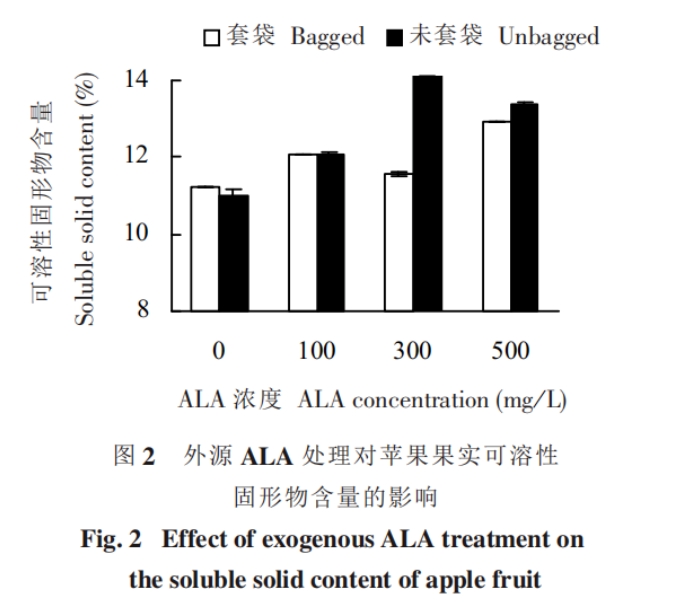
As can be seen from the above results, ALA treatment can significantly increase the soluble solid content of apple fruit. Whether the fruit is bagged or not. The soluble solid content of fruit treated with ALA was significantly higher than that of untreated control, reaching a very significant level.
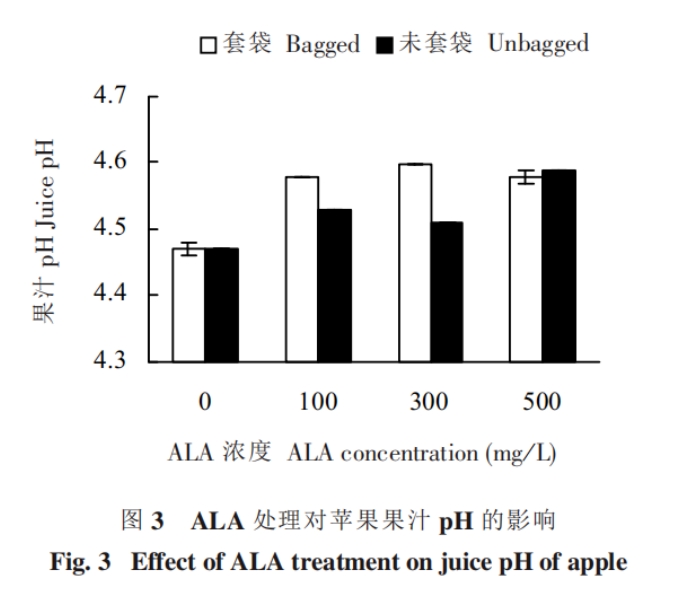
FIG. 3 shows that the pH of fruit juice treated with ALA is significantly higher than that of the control, and the titrable acid content is significantly lower than that of the control (data is not listed), so the fruit solid acid ratio is significantly improved
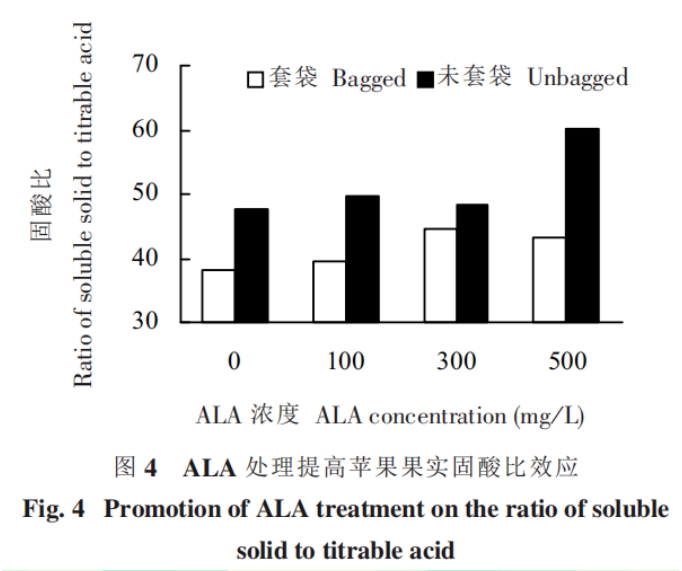
(Figure 4). The increase of solid acid ratio of bagged fruit was 3%~17%, and that of unbagged fruit was 4%~27%.
2.3 Effect of ALA treatment on shelf life of apple fruit
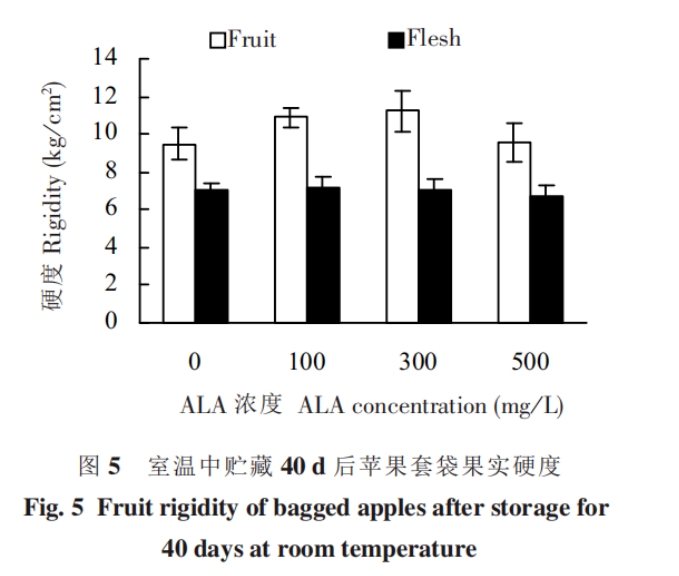
As can be seen from the above results, bagging had no significant effect on the hardness of apple fruit, and the hardness of fruit with skin and peeled flesh at the time of harvesting was 10 kg/cm and 8.8 kg/ cm2, respectively. Exogenous ALA treatment also had no effect on the hardness of apple during the harvesting period. The apples were stored at room temperature. After 40 days, the hardness of bagged fruits was measured again (FIG. 5). Although the pulp hardness had significantly decreased (about 7kg/cm2), the pulp hardness treated by ALA was not lower than that of the control, but the fruit hardness was slightly higher than that of the control.
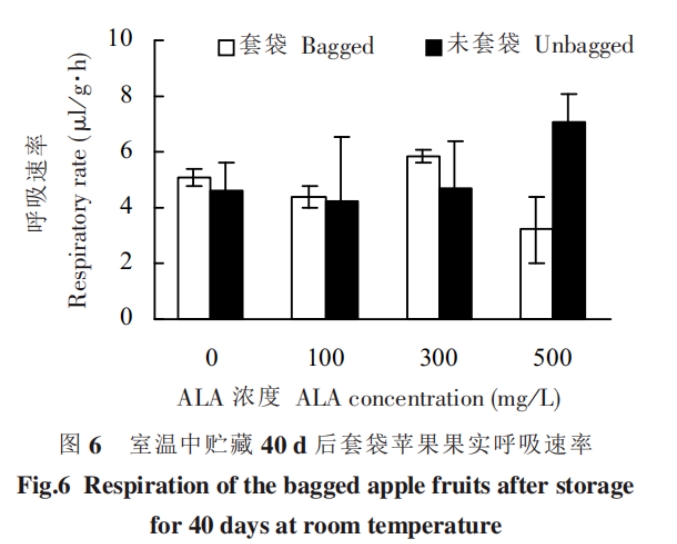
On the other hand, from the perspective of fruit respiratory intensity stored for 40 days, the respiration rate of unbagged fruits treated with 500 mg/L ALA was significantly higher than that of the control group (P<0.05), and there was no significant difference between the other fruits and the control group (FIG. 6). Therefore, exogenous ALA treatment with appropriate concentration did not affect the respiration rate and shelf life of apples.
In this issue, apple was used as a test material, and the application of 5-ALA (ALA) in Apple was studied in depth. The results showed that:
The appearance color is an important indicator of the marketability of apple fruit. However, in many apple producing areas in China, especially in the former Yellow River area, due to insufficient light intensity and other reasons, often poor coloring. Affect the quality of fruit and market sales. It has been clear that the most critical internal and external factors affecting apple coloring are photosensitive element activity and light intensity. Different from previous reports, this paper proposed that exogenous ALA treatment with a certain concentration not only significantly increased the anthocyanin content of apple peel and improved the appearance quality, but also increased the soluble solid content and solid acid ratio of the fruit, thus improving the internal quality without shortening the shelf life of the fruit. Its effect of promoting coloring is no less than that of auxin or etheolin without the side effects of the latter exogenous ALA treatment: First of all,ALA is an endogenous substance that exists in all organisms, whether it is plants or the human body contains ALA, and its molecular weight is only 131, does not have antigenicity, and therefore, does not cause human antigen antibody reaction. Secondly, ALA is unstable to light. ALA, which is attached to the surface of the fruit, promotes the color of the apple while itself being broken down by light.
In summary, 20 days before the ripening of apple fruits, the treatment with exogenous 5-ALA (ALA) of 100~500mg/L significantly promoted the accumulation of anthocyanins in fruit peel.